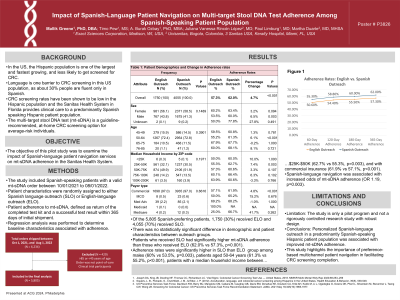Tuesday Poster Session
Category: Colorectal Cancer Prevention
P3826 - Impact of Spanish Language Patient Navigation on Multi-Target Stool DNA Test Adherence Among Spanish-Speaking Patient Population
Tuesday, October 29, 2024
10:30 AM - 4:00 PM ET
Location: Exhibit Hall E

Has Audio
- MG
Mallik Greene, PhD
Exact Sciences
Madison, WI
Presenting Author(s)
Mallik Greene, PhD1, Timo Pew, MS1, A. Burak Ozbay, MBA, PhD2, Juliana V. Rincón López, MSc3, Paul Limburg, MD, MPH4, Martha Duarte, MD, MHSA5
1Exact Sciences, Madison, WI; 2Exact Sciences, Lake Forest, IL; 3Fundación Universitaria Sanitas, Bogotá, Distrito Capital de Bogota, Colombia; 4Exact Sciences, Rochester, MN; 5Sanitas USA, Keralty Hospital, Miami, FL
Introduction: In the US, the Hispanic population is one of the largest and fastest growing, and less likely to get screened for CRC. Language is one barrier to CRC screening in this US population, as about 30% fluent only in Spanish. The Sanitas Health System in Florida has a low CRC screening rate and provides clinical care to a predominantly Spanish speaking Hispanic patient population. The multi-target stool DNA test (mt-sDNA) is a guideline-recommended, at-home CRC screening option for average-risk individuals. The objective of this pilot study was to examine the impact of Spanish-language patient navigation services on mt-sDNA adherence in the Sanitas Health System.
Methods: The study included Spanish-speaking patients with a valid mt-sDNA order between 10/01/2021 to 08/01/2022. Patient characteristics were matched between the groups before they were assigned to either Spanish language outreach (SLO) or English-language outreach (ELO). Patient adherence to mt-sDNA adherence, defined as return of the completed test kit and a successful test result within 365 days of initial shipment. Regression analysis was performed to determine available baseline characteristics associated with adherence.
Results: Of the 5,805 Spanish-preferring patients, 1,750 (30%) received ELO and 4,055 (70%) received SLO. There was no statistically significant difference in demographic and patient characteristics between outreach groups. Patients who received SLO had significantly higher mt-sDNA adherence than those who received ELO (62.0% vs 57.3%, p< 0.001). Adherence rates were significantly higher in SLO than ELO group among males (60% vs 53.5%, p=0.003), patients aged 50-64 years (61.3% vs 55.2%, p< 0.001), patients with a median household income between $25K-$50K (62.7% vs 55.3%, p=0.003), with commercial insurance (61.9% vs 57.1%, p< 0.001), in metropolitan areas (62% vs 57.4%, p< 0.001), and new to mt-sDNA (64.5% vs 59.8%, p=0.003). Spanish-language navigation was associated with increased odds of mt-sDNA adherence (OR 1.19, p=0.003).
Discussion: Personalized Spanish-language outreach in a predominantly Spanish-speaking Hispanic patient population was associated with improved mt-sDNA adherence. This study highlights the importance of preference-based multichannel patient navigation in facilitating CRC screening completion.
Disclosures:
Mallik Greene, PhD1, Timo Pew, MS1, A. Burak Ozbay, MBA, PhD2, Juliana V. Rincón López, MSc3, Paul Limburg, MD, MPH4, Martha Duarte, MD, MHSA5. P3826 - Impact of Spanish Language Patient Navigation on Multi-Target Stool DNA Test Adherence Among Spanish-Speaking Patient Population, ACG 2024 Annual Scientific Meeting Abstracts. Philadelphia, PA: American College of Gastroenterology.
1Exact Sciences, Madison, WI; 2Exact Sciences, Lake Forest, IL; 3Fundación Universitaria Sanitas, Bogotá, Distrito Capital de Bogota, Colombia; 4Exact Sciences, Rochester, MN; 5Sanitas USA, Keralty Hospital, Miami, FL
Introduction: In the US, the Hispanic population is one of the largest and fastest growing, and less likely to get screened for CRC. Language is one barrier to CRC screening in this US population, as about 30% fluent only in Spanish. The Sanitas Health System in Florida has a low CRC screening rate and provides clinical care to a predominantly Spanish speaking Hispanic patient population. The multi-target stool DNA test (mt-sDNA) is a guideline-recommended, at-home CRC screening option for average-risk individuals. The objective of this pilot study was to examine the impact of Spanish-language patient navigation services on mt-sDNA adherence in the Sanitas Health System.
Methods: The study included Spanish-speaking patients with a valid mt-sDNA order between 10/01/2021 to 08/01/2022. Patient characteristics were matched between the groups before they were assigned to either Spanish language outreach (SLO) or English-language outreach (ELO). Patient adherence to mt-sDNA adherence, defined as return of the completed test kit and a successful test result within 365 days of initial shipment. Regression analysis was performed to determine available baseline characteristics associated with adherence.
Results: Of the 5,805 Spanish-preferring patients, 1,750 (30%) received ELO and 4,055 (70%) received SLO. There was no statistically significant difference in demographic and patient characteristics between outreach groups. Patients who received SLO had significantly higher mt-sDNA adherence than those who received ELO (62.0% vs 57.3%, p< 0.001). Adherence rates were significantly higher in SLO than ELO group among males (60% vs 53.5%, p=0.003), patients aged 50-64 years (61.3% vs 55.2%, p< 0.001), patients with a median household income between $25K-$50K (62.7% vs 55.3%, p=0.003), with commercial insurance (61.9% vs 57.1%, p< 0.001), in metropolitan areas (62% vs 57.4%, p< 0.001), and new to mt-sDNA (64.5% vs 59.8%, p=0.003). Spanish-language navigation was associated with increased odds of mt-sDNA adherence (OR 1.19, p=0.003).
Discussion: Personalized Spanish-language outreach in a predominantly Spanish-speaking Hispanic patient population was associated with improved mt-sDNA adherence. This study highlights the importance of preference-based multichannel patient navigation in facilitating CRC screening completion.
Disclosures:
Mallik Greene: exact sciences – Employee.
Timo Pew: Exact Sciences – Employee, Stock-publicly held company(excluding mutual/index funds).
A. Burak Ozbay: Exact Sciences – Employee, Stock Options.
Juliana Rincón López indicated no relevant financial relationships.
Paul Limburg: Exact Sciences Corporation – Consultant, Employee, Stock-publicly held company(excluding mutual/index funds).
Martha Duarte indicated no relevant financial relationships.
Mallik Greene, PhD1, Timo Pew, MS1, A. Burak Ozbay, MBA, PhD2, Juliana V. Rincón López, MSc3, Paul Limburg, MD, MPH4, Martha Duarte, MD, MHSA5. P3826 - Impact of Spanish Language Patient Navigation on Multi-Target Stool DNA Test Adherence Among Spanish-Speaking Patient Population, ACG 2024 Annual Scientific Meeting Abstracts. Philadelphia, PA: American College of Gastroenterology.
